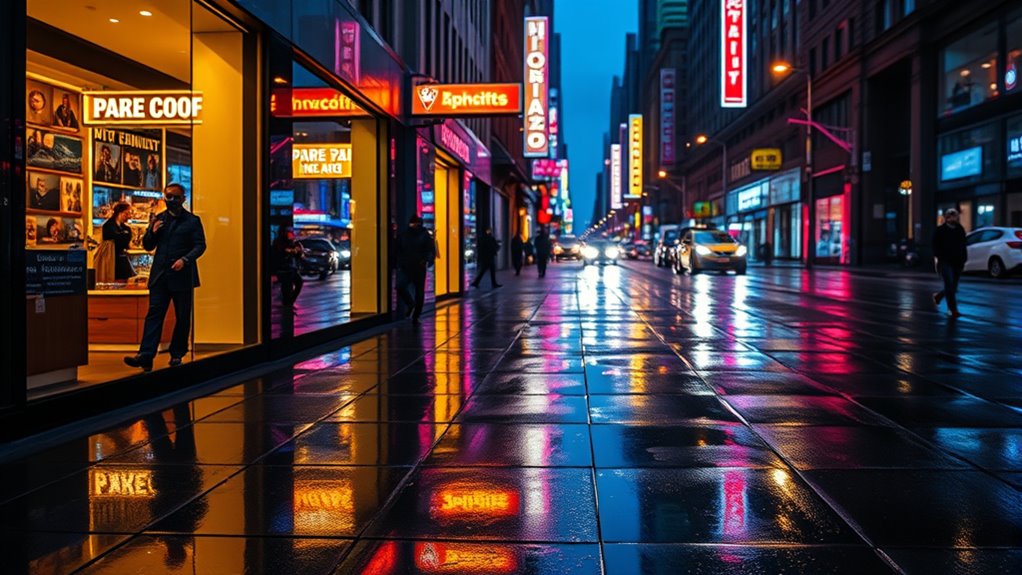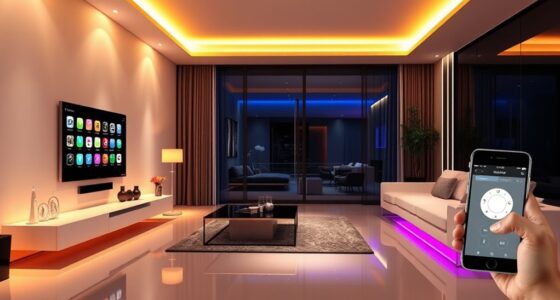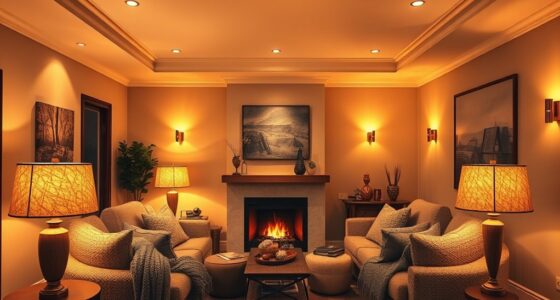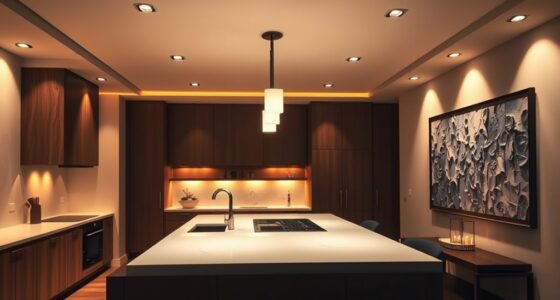Reflective surfaces bounce light around your space, making it feel brighter and bigger. When you place mirrors or shiny objects strategically, they spread natural or artificial light, reducing shadows and creating a lively atmosphere. Diffusing light through metallic or glass surfaces softens harsh contrasts, enhancing mood and comfort. By understanding how reflection affects perception, you can transform your environment into a more vibrant and welcoming space. Keep exploring to discover how to optimize these effects for your surroundings.
Key Takeaways
- Reflective surfaces bounce natural and artificial light, increasing overall brightness and creating a more lively atmosphere.
- They amplify light distribution, reducing shadows and softening contrasts, which enhances the mood’s warmth and comfort.
- Mirrors and shiny materials reflect visual elements, enriching decor and fostering a sense of spaciousness and vibrancy.
- Strategic placement of reflective surfaces maximizes light entry and diffusion, making spaces feel larger and more inviting.
- Enhanced illumination through reflection can elevate mood, energize environments, and create dynamic visual effects.
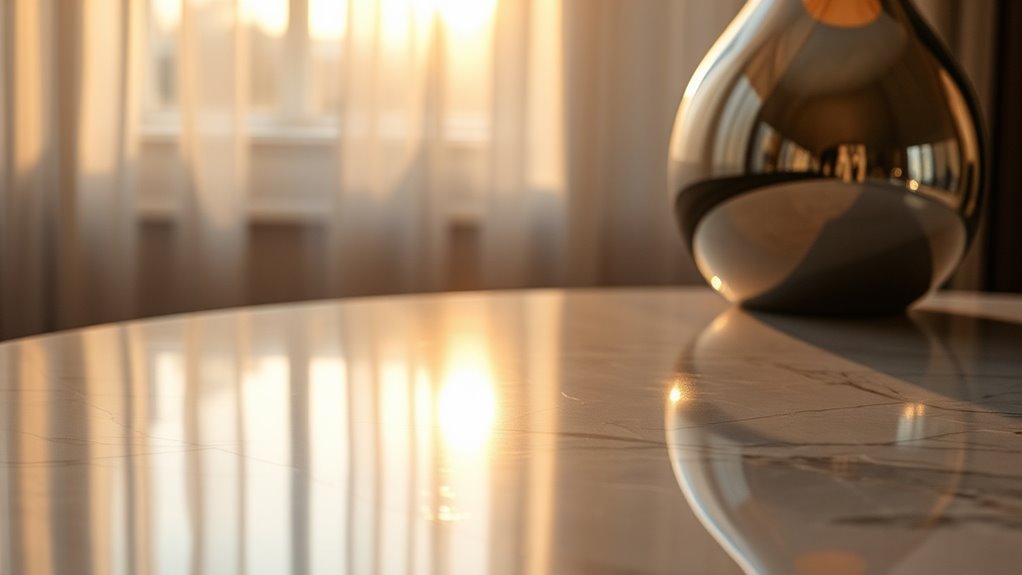
Reflective surfaces play a essential role in how light interacts with our surroundings, creating images, illusions, and visual effects that shape our perception of space. When you introduce mirrors or other shiny surfaces into a room, you’re not just adding decor—you’re manipulating how light moves and spreads. Mirror illusions, for instance, can make a space seem larger or more complex than it truly is. When light hits a mirror, it bounces off at an angle, creating a reflection that visually doubles the area or introduces new focal points. This bouncing of light enhances brightness, making the environment feel more open and lively.
Reflective surfaces expand space and brighten environments through clever light manipulation and visual illusions.
Light diffusion is another key concept when considering reflective surfaces. Surfaces like polished metal, glass, or even certain plastics scatter light in multiple directions, softening shadows and reducing harsh contrasts. This diffusion creates a more even, gentle illumination that can influence the mood of a space. For example, a room with a large mirror or glossy wall can bounce light around, reducing dark corners and creating a warm, inviting atmosphere. You might notice how a beautifully placed mirror reflects both natural and artificial light, spreading it across the room and amplifying its effects. The more light you diffuse, the more balanced and harmonious the space appears, which can positively affect your mood and comfort.
Using mirror illusions strategically allows you to play with perception. You can position a mirror to reflect a natural light source, such as a window, to maximize daylight entry. This not only brightens the room but also creates a sense of depth, making the space feel more expansive. Additionally, mirrors can reflect artwork, decorative objects, or even a flickering candle flame, multiplying their visual impact and creating mesmerizing visual effects. As light bounces and diffuses, it transforms the space into a dynamic environment, constantly changing with the movement of light throughout the day. Incorporating reflective surfaces can also influence the contrast ratio, enhancing the overall image quality in a room or on a projector screen.
Ultimately, reflective surfaces are more than just decorative elements—they’re tools that influence how you perceive and experience a space. By understanding how mirror illusions and light diffusion work together, you can manipulate light to enhance mood, create illusions of size, and craft a more inviting, vibrant environment. When you harness the power of reflection, you’re not just decorating; you’re shaping how light and space interact to influence your feelings and perceptions every day.
Frequently Asked Questions
How Do Reflective Surfaces Affect Indoor Lighting Energy Efficiency?
Reflective surfaces boost indoor lighting energy efficiency by increasing surface brightness and improving light distribution. When you use mirrors or glossy materials, they bounce light around the room, reducing the need for additional artificial lighting. This means you can save energy and lower electricity costs. By strategically placing reflective surfaces, you enhance overall brightness and create a more evenly lit space, making your environment more comfortable and energy-efficient.
Can Reflective Surfaces Influence Temperature Regulation in a Space?
Imagine reflective surfaces turning your space into a thermal battleground! They can influence temperature regulation by bouncing heat and light, affecting thermal comfort. When surfaces are highly reflective, they reduce surface heat transfer, keeping rooms cooler or warmer depending on the season. So yes, your choice of reflective materials can dramatically change how your space manages temperature, making it feel just right or uncomfortably hot, all through surface heat transfer dynamics.
What Materials Are Best for Creating Effective Reflective Surfaces?
You should choose materials like mirror finishes or polished metals for creating effective reflective surfaces. These materials have highly smooth, shiny surfaces that bounce light efficiently, making spaces appear brighter and more open. Mirror finishes are especially effective in reflecting both natural and artificial light, while polished metals like stainless steel or aluminum provide durability and a sleek look. Using these materials enhances light distribution and can positively influence the mood of your space.
How Do Reflective Surfaces Impact Privacy in Architectural Design?
Did you know that 60% of people worry about privacy concerns in buildings with reflective surfaces? Reflective surfaces can compromise visual privacy by allowing outsiders to see inside, which makes you more vulnerable to privacy breaches. As you incorporate these materials into your design, consider how they might affect privacy concerns. Using strategic placement or adding privacy screens can help protect your space without sacrificing aesthetic appeal.
Are There Health Concerns Related to Excessive Exposure to Reflected Light?
You might wonder if reflective surfaces pose health risks from excess reflected light. While generally safe, prolonged exposure to intense reflected light can increase skin damage and risk of skin cancer. It’s smart to limit your time in highly reflective environments and wear protective clothing or sunscreen. Being aware of these risks helps you enjoy reflective surfaces without compromising your health. Moderation is key to avoiding potential skin damage.
Conclusion
Just as a mirror acts as a silent storyteller, reflecting more than just your image, reflective surfaces in your space can amplify light and mood, turning a simple room into a vibrant tableau. Think of them as the quiet artisans weaving a tapestry of illumination and emotion, guiding your environment’s energy with subtlety and grace. Embrace these surfaces, and watch how they transform your space into a living, breathing mirror of your mood and light.
